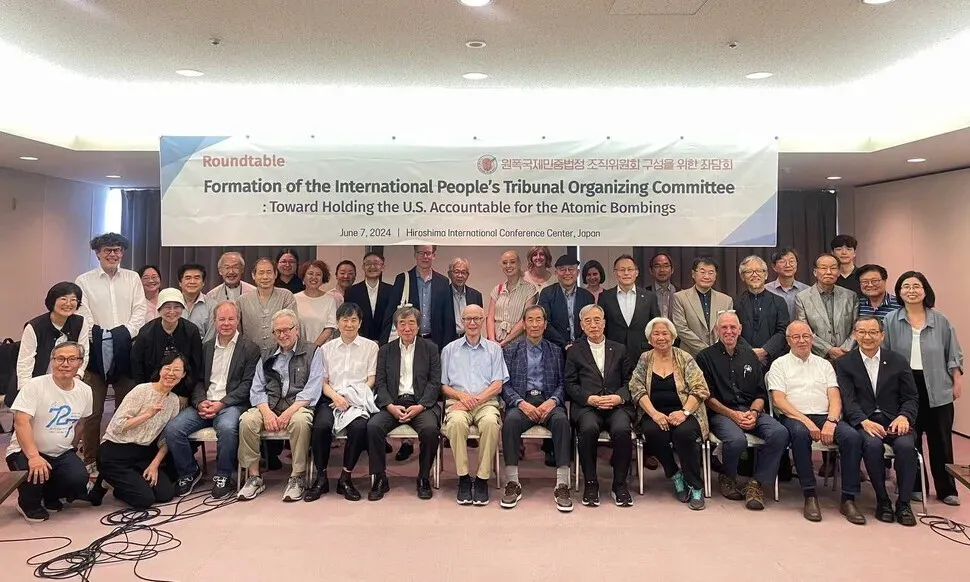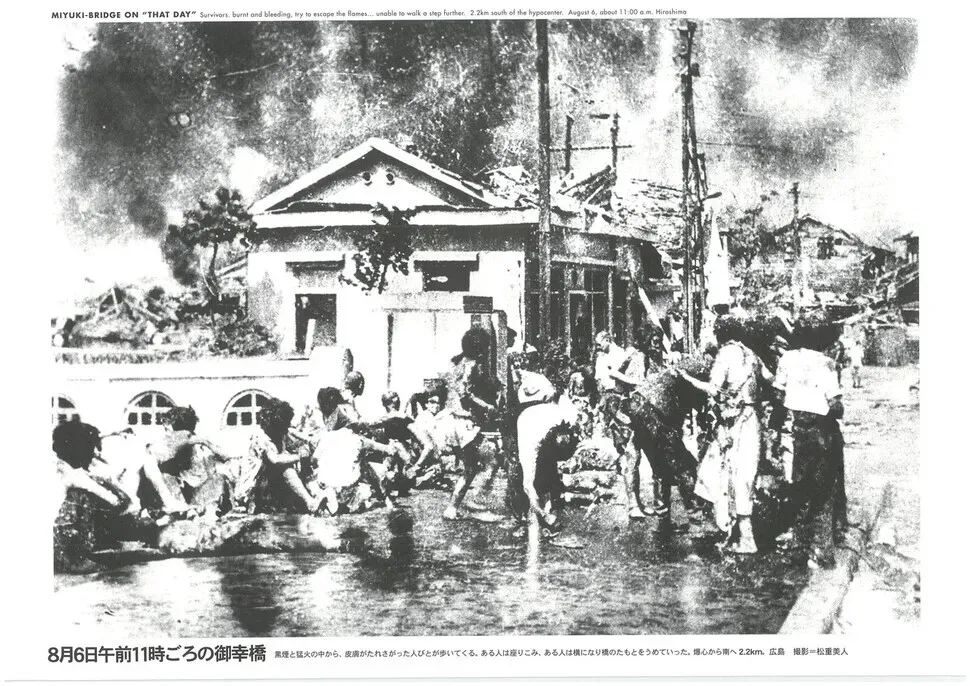hankyoreh
Links to other country sites 다른 나라 사이트 링크
People’s tribunal seeks US accountability for 1945 atomic bombings

World War II was reaching its denouement in the summer of 1945 when, on Aug. 6 and Aug. 9, the US dropped atomic bombs on the Japanese cities of Hiroshima and Nagasaki, marking the first instance that humanity used nuclear weapons in actual combat.
Around 40,000 Koreans living in those cities are thought to have lost their lives due to those bombings. Out of the 30,000 Korean survivors, 23,000 returned to their liberated motherland, only to be neglected by both the South Korean and Japanese governments and die after languishing in poverty.
As of Aug. 29, 2025, there remain only 1,577 South Korean survivors of the Hiroshima and Nagasaki nuclear bombings.
Korean atomic bomb victims recognized by the Japanese government have received support from the Japanese government for medical expenses since 1994. For those excluded, the Korean government has been able to offer support following the enactment of the Special Act on Support for Korean Atomic Bomb Victims in 2016, some 71 years after the bombing.
However, the children and grandchildren of victims who continue to battle illnesses presumed to be genetically inherited are still excluded from receiving medical support. A revision to the special act aiming to address this gap was submitted to the National Assembly, but remains in limbo. Meanwhile, there has been no official apology or reparation from the US or Japanese governments.

Consequently, international civil society organizations have stepped forward to open a civil tribunal demanding an official apology and reparations from the US. This is the International People’s Tribunal on the 1945 US Atomic Bombings.
The people’s tribunal originated as an endeavor honoring the will of the late Kim Hyeong-ryul, the first president of the Association for the Second Generation of Korean Atomic Bomb Survivors who passed away at the age of 35 in 2005. Before his passing, Kim reportedly expressed his wish that the United States be made to apologize. Consequently, in May 2015, Kim’s father and Shim Jin-tae, another atomic bomb survivor, asked the civic group Solidarity for Peace and Reunification of Korea (SPARK) to explore the possibility of a lawsuit in a US court. The Korean Atomic Bomb Victims Association also made a request to SPARK in August 2019 to establish a people’s tribunal.
Last June, the international organizing committee for the people’s tribunal was launched in Hiroshima, Japan, in response to these requests. Kang U-il, the former president of the Catholic Bishops’ Conference of Korea, former Hiroshima Mayor Takashi Hiraoka, and Archbishop John Wester of Santa Fe in New Mexico, US, serve as co-chairs. SPARK and Brad Wolf, an American lawyer and former prosecutor, are handling coordination for the tribunal.
The people’s tribunal is a citizen-led judicial process that aims to hold the US accountable for its use of atomic bombs in 1945. Although attempts were made to bring the US to an official court under international law, it proved difficult because the commanders who ordered the bombings have passed away. That led relevant organizations to opt for a mock tribunal. While the people’s tribunal has no legally binding power, it aims to be the first step in securing a formal apology from the US and reparations for Korean atomic bomb victims by establishing US culpability. Furthermore, the tribunal seeks to contribute to strengthening international norms prohibiting the possession and use of nuclear weapons.

The plaintiffs are 13 Korean victims of the atomic bombings: six who are of the first generation, six who are of the second generation, and one from the third generation. Kim Hyeong-ryul’s brother is among these individuals, seeking justice on his late brother’s behalf. The group will appear before the tribunal to argue that the nuclear bombings of Hiroshima and Nagasaki were illegal, and to demand an official apology and reparation from the US government.
The plaintiffs are represented by four attorneys, including Daniel Rietiker, a lawyer and professor of international law at the University of Lausanne in Switzerland. The defendant is the United States. The US side’s attorneys have not yet been confirmed. The judiciary consists of five members: two from the US, one from Somalia, one from Korea, and one additional judge yet to be confirmed. Considering that this issue is of international interest, legal professionals and scholars of international law from multiple countries are being appointed.
During an Aug. 13 visit to Hapcheon County, South Gyeongsang Province — often called “Korea’s Hiroshima” due to its high concentration of atomic bomb victims — Melissa Parke, the executive director of the International Campaign to Abolish Nuclear Weapons, also expressed her support for the plaintiffs through SPARK.

The people’s tribunal will be held near the United Nations building in New York, where the first review conference of the UN Treaty on the Prohibition of Nuclear Weapons will take place next November. The judiciary will review documents submitted in advance by attorneys for both the prosecution and the defendant. On the day of the trial, it will hear closing arguments from both sides and consider opinions from international law experts as well as representatives of international civil society organizations. After all statements are concluded, the judiciary will read its verdict. The US is expected to be found guilty. The verdict will be sent to the US government and the Treaty on the Prohibition of Nuclear Weapons review conference.
“The people’s tribunal is the first civilian-led international court to confirm the illegality of the US atomic bombings in 1945, demand an apology from the US and secure reparations for the victims,” said Oh Hye-ran, the executive director of SPARK.
“Few survivors of the atomic bombings remain. We aim to resolve the long-neglected grievances of these victims while they are still alive, and to urge the international community to pay attention to the second and third generations of atomic bomb victims who lack legal protections,” she said.
By Kim Kwang-soo, Busan correspondent
Please direct questions or comments to [english@hani.co.kr]

Editorial・opinion
![[Column] Korea’s young men need liberating too [Column] Korea’s young men need liberating too](https://flexible.img.hani.co.kr/flexible/normal/331/199/imgdb/original/2025/1109/4617626490179221.jpg) [Column] Korea’s young men need liberating too
[Column] Korea’s young men need liberating too![[Correspondent’s column] Yet another fragmented Sado mine memorial [Correspondent’s column] Yet another fragmented Sado mine memorial](https://flexible.img.hani.co.kr/flexible/normal/500/300/imgdb/original/2025/1107/2517625049628864.jpg) [Correspondent’s column] Yet another fragmented Sado mine memorial
[Correspondent’s column] Yet another fragmented Sado mine memorial- [Column] Why is South Korea clamoring for yesterday’s nuclear submarines?
- [Column] The banality of Korea’s ‘democratic fascism’
- [Editorial] New York City elects a potent foil to Trump
- [Column] Nuclear submarines and the paradoxes of pursuing denuclearization
- [Editorial] Korea must find a new equilibrium between US and China
- [Column] Trump’s protection racket
- [Editorial] Devil will be in the details of Korea-US trade deal
- [Editorial] Lee must stick to guiding principles in tariff negotiations
Most viewed articles
- 1[Column] Korea’s young men need liberating too
- 2Newly discovered letters show Japanese diplomat played part in assassination of Queen Min
- 3Don’t hold your breath for China to lift restrictions on Korean cultural content
- 4[News analysis] How KIKO derivatives devasted S. Korean small and medium-sized exporters
- 5[Editorial] Opposing Da Vinci Code and Freedom of Expression
- 6Real-life heroes of “A Taxi Driver” pass away without having reunited
- 7Koreans are getting taller, but half of Korean men are now considered obese
- 8Architect of denuclearization policy says it’s time South Korea pursues nuclear latency
- 9Week after US-Korea summit, lack of tariff deal fact sheet raises doubts
- 10[Editorial] New York City elects a potent foil to Trump